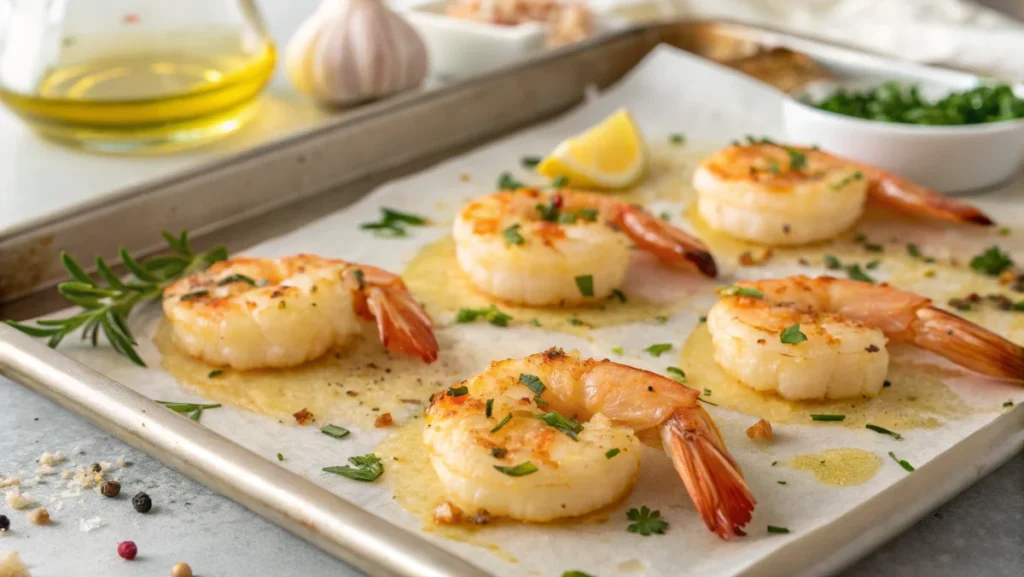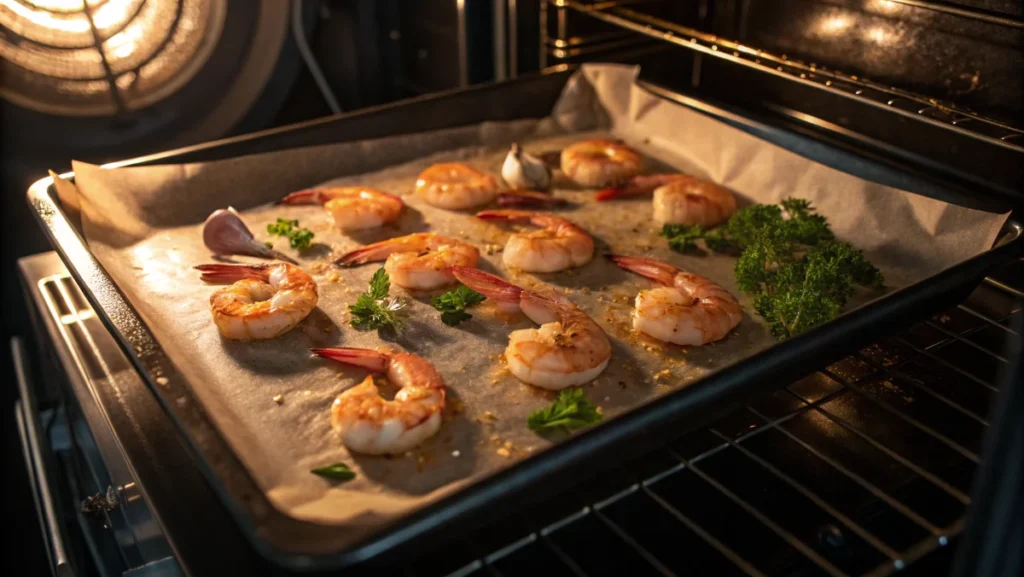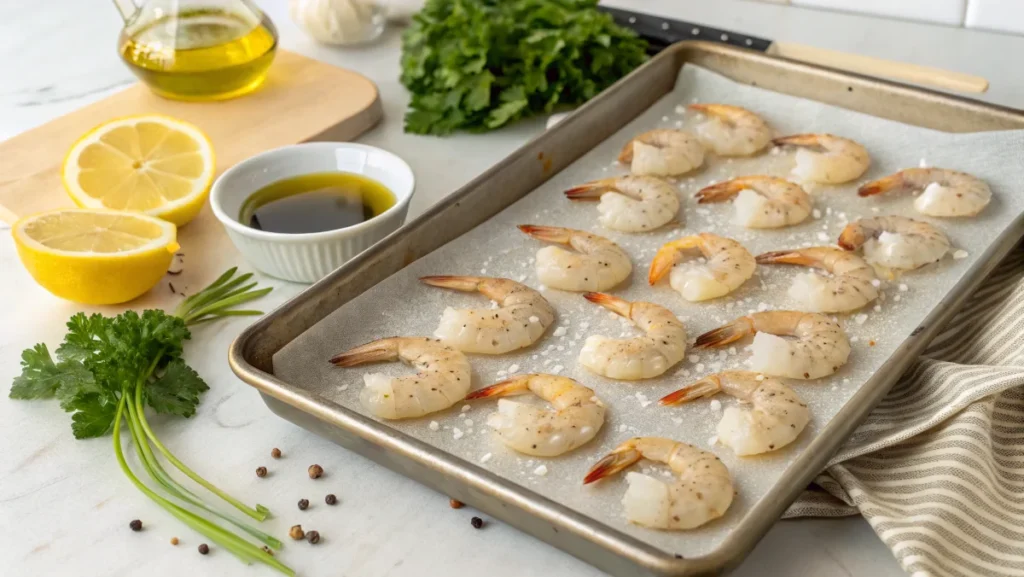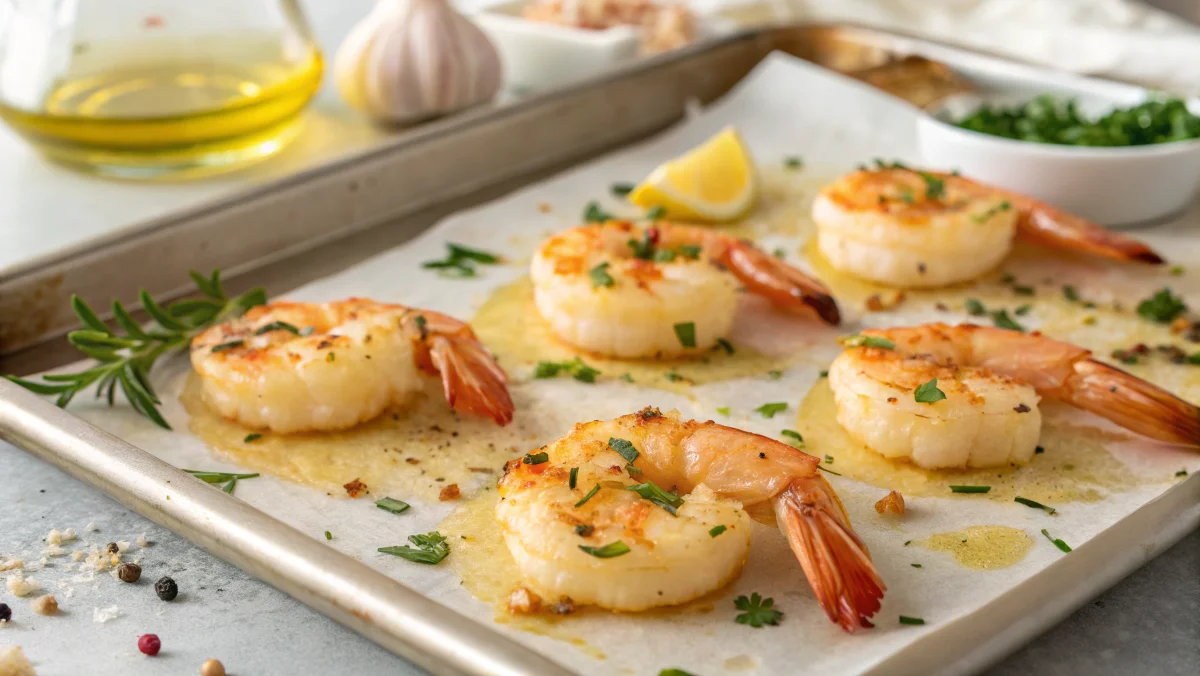Shrimp is a versatile and delicious seafood that can be prepared in numerous ways. Among the most popular methods, baking shrimp in the oven stands out for its simplicity and ability to deliver tender, flavorful results. However, to achieve the perfect outcome every time, paying attention to the temperature for shrimp is essential, as it plays a crucial role in ensuring even cooking and optimal texture. Using the correct oven temperature not only enhances flavor but also ensures that the shrimp maintains its optimal texture. For detailed guidance on this, you can explore How Long Should You Cook Shrimp in the Oven at 400 Degrees? | Complete Baking Guide.

Table of Contents
The Importance of Cooking Shrimp at the Right Temperature
When it comes to cooking shrimp, the temperature is a key factor that determines the final result. If the oven is too hot, the shrimp can become rubbery, overcooked, and dry. Conversely, if the oven is not hot enough, the shrimp may remain undercooked, tough, and unappetizing. Therefore, knowing what is the best temperature for shrimp in the oven is essential to achieving that perfect bite.
- Shrimp cooks quickly, which is why high temperatures are often recommended.
- A moderate temperature, typically around 400°F, ensures the shrimp cooks evenly, allowing the natural sweetness and flavor to shine.
- At the right temperature, shrimp retains moisture, preventing it from drying out while also enhancing its natural succulent texture.
In summary, cooking shrimp at the correct temperature is not only about improving flavor, but it also contributes to the overall dining experience. Ensuring that the shrimp is neither overcooked nor undercooked relies heavily on precision with temperature.
Optimal Oven Temperatures for Baking Shrimp
When baking shrimp, it’s important to understand that the optimal oven temperature can vary slightly based on the size of the shrimp and the desired outcome. However, in most cases, you can rely on a few general temperature guidelines to help you cook shrimp to perfection.
- 400°F (200°C): This is often considered the ideal temperature for baking shrimp. At this temperature, the shrimp cooks quickly without drying out, retaining its natural flavor and moisture.
- 375°F (190°C): A slightly lower temperature works well for those who prefer a more gradual cooking process. It ensures the shrimp cooks evenly, though it might take a few extra minutes compared to baking at 400°F.
- 425°F (220°C): If you’re looking for a slightly crispier texture, baking shrimp at a higher temperature like 425°F can yield good results. However, you should watch the shrimp closely to prevent overcooking.
In essence, the key to success lies in baking shrimp at a moderate-to-high heat, ensuring both a crisp outer layer and a tender interior. But the question still lingers: What is the best temperature for shrimp in the oven? For most home cooks, 400°F strikes the perfect balance.

How Temperature Affects Shrimp Texture and Flavor
The temperature at which you cook shrimp can significantly affect both its texture and flavor. Because shrimp are delicate, they require careful attention to ensure they do not become overcooked or undercooked.
- Low temperatures (below 375°F) may result in shrimp that are chewy or soggy, as they may not develop a crisp exterior.
- High temperatures (above 425°F) can quickly dry out shrimp, leaving them rubbery and tough.
At the right temperature, shrimp cooks in a way that enhances its natural flavor, delivering a perfect balance of sweetness and savory notes. A moderate temperature, around 400°F, allows the shrimp to retain moisture while the heat promotes caramelization on the exterior, adding depth to the flavor profile.
In addition to texture and flavor, the temperature also influences the shrimp’s overall appearance. When cooked properly, shrimp should have a slight golden-brown crust on the outside, while the inside remains succulent and juicy.
Step-by-Step Guide to Cooking Shrimp in the Oven
Cooking shrimp in the oven is straightforward when you follow a few simple steps. To ensure success, it’s important to maintain the correct temperature and timing. Here’s a step-by-step guide to help you prepare perfectly baked shrimp.
Step 1: Preheat the Oven
Preheat your oven to 400°F (200°C), or your desired temperature. This will ensure that the oven is fully heated when you’re ready to cook the shrimp.
Step 2: Prepare the Shrimp
- Peel and devein the shrimp if necessary.
- You can leave the shells on for extra flavor or remove them if you prefer a cleaner presentation.
- Pat the shrimp dry using a paper towel to ensure the seasoning sticks.
Step 3: Season the Shrimp
Season the shrimp with your favorite spices, herbs, and oils. This is the moment to get creative—garlic, lemon, paprika, and parsley are popular choices.
Step 4: Arrange Shrimp on a Baking Sheet
Place the shrimp in a single layer on a baking sheet lined with parchment paper or foil. This will prevent sticking and make cleanup easier.
Step 5: Bake the Shrimp
Place the baking sheet in the oven and bake for about 8-10 minutes, or until the shrimp turn pink and opaque. Remember that cooking times may vary slightly depending on the size of the shrimp.
Step 6: Check for Doneness
The shrimp should be firm to the touch and fully opaque when done. You can also use a meat thermometer to check for an internal temperature of 120-130°F.
By following these steps, you’ll have perfectly cooked shrimp every time.

Common Mistakes When Baking Shrimp and How to Avoid Them
Baking shrimp may seem like an easy task, but several common mistakes can prevent you from achieving the ideal results. Here are some pitfalls to avoid:
Mistake 1: Overcooking Shrimp
One of the most common mistakes is leaving shrimp in the oven too long. Shrimp cooks quickly, and overcooking can lead to a tough, rubbery texture. Always check the shrimp at the lower end of the cooking time range.
Mistake 2: Not Preheating the Oven
Failing to preheat the oven can result in uneven cooking. Preheating ensures the shrimp cooks at the desired temperature from the moment it enters the oven.
Mistake 3: Using Too High of a Temperature
While high temperatures can help achieve a crisp exterior, they can also dry out shrimp if used improperly. Stick to moderate heat (around 400°F) for the best results.
Mistake 4: Crowding the Shrimp
Overcrowding the baking sheet can lead to uneven cooking. Be sure to give each shrimp enough space to cook evenly.
By being mindful of these mistakes, you can enhance your shrimp-cooking technique and enjoy consistently delicious results.
Ideal Cooking Times for Different Shrimp Sizes
Shrimp come in various sizes, and cooking time can vary depending on the size of the shrimp. Here’s a guide to help you adjust the cooking time based on shrimp size:
- Small Shrimp (51/60 count): These shrimp require about 6-8 minutes of baking time at 400°F.
- Medium Shrimp (41/50 count): Bake for 8-10 minutes at 400°F.
- Large Shrimp (31/40 count): These shrimp need 10-12 minutes of baking time at 400°F.
- Extra-Large Shrimp (21/25 count): Bake for 12-14 minutes at 400°F.
Be sure to monitor the shrimp closely as cooking times can vary based on oven type and shrimp thickness.
How to Season Shrimp for Perfect Oven Results
Seasoning is crucial for adding flavor to baked shrimp. Whether you prefer a simple lemon-garlic seasoning or a more complex spice blend, here are some tips for the best results:
- Garlic and Butter: One of the most popular flavor combinations for shrimp is garlic and butter. Melt butter, then mix in minced garlic, lemon juice, and herbs.
- Spicy Cajun: For a spicy kick, coat the shrimp in a mixture of paprika, cayenne pepper, garlic powder, onion powder, and thyme.
- Lemon and Herb: A simple seasoning of lemon zest, fresh parsley, and a pinch of salt is a light yet flavorful option.
- Asian-Inspired: For an Asian flair, combine soy sauce, sesame oil, ginger, and green onions for a savory and aromatic seasoning.
Remember, it’s essential not to over-season. Shrimp has a delicate flavor that should be complemented, not overshadowed, by the seasoning.
Using a Meat Thermometer to Check Shrimp Doneness
A meat thermometer is a handy tool to ensure your shrimp is perfectly cooked. Shrimp should be cooked until it reaches an internal temperature of 120-130°F. To check for doneness, insert the thermometer into the thickest part of the shrimp. When the shrimp is fully cooked, it will appear opaque and firm to the touch.
Using a thermometer eliminates any guesswork and helps you avoid overcooking your shrimp, ensuring that each bite is succulent and juicy.
Health Benefits of Cooking Shrimp at the Right Temperature
Cooking shrimp at the right temperature doesn’t just improve its taste and texture; it also preserves its nutritional value. Shrimp is a high-protein, low-calorie food that provides essential vitamins and minerals, including vitamin B12, iodine, and selenium. However, overcooking can diminish its nutritional content.
By cooking shrimp at the right temperature:
- You preserve the vitamins and minerals that are sensitive to heat.
- The shrimp’s omega-3 fatty acids remain intact, supporting heart health.
- The overall texture remains tender, preventing the loss of important nutrients that can occur when shrimp becomes dry or rubbery.
Therefore, the right cooking temperature not only enhances the taste of your shrimp but also ensures that you’re getting the maximum health benefits.
Best Recipes for Oven-Baked Shrimp
There are countless ways to prepare shrimp in the oven, but here are some popular recipes that guarantee delicious results:
- Garlic Butter Shrimp: This classic recipe combines butter, garlic, lemon, and herbs for a rich and flavorful dish.
- Baked Cajun Shrimp: Coated with Cajun seasoning, this spicy version of baked shrimp is perfect for those who love heat.
- Parmesan Crusted Shrimp: Topped with a crispy Parmesan crust, this shrimp is both flavorful and satisfying.
- Lemon Herb Shrimp: For a light and refreshing option, lemon, garlic, and fresh herbs provide a simple but flavorful dish.
Experimenting with different flavor combinations will help you discover the perfect recipe for your oven-baked shrimp.
How to Reheat Shrimp Without Losing Flavor
Reheating shrimp can be tricky, as overcooking it can result in a rubbery texture. To reheat shrimp without losing flavor:
- Use the oven: Preheat your oven to 300°F (150°C), place the shrimp on a baking sheet, and bake for 5-7 minutes. This method helps preserve moisture.
- Stovetop: Heat shrimp in a pan with a small amount of butter or oil on low heat. This will help keep the shrimp from drying out.
- Microwave: If you must use a microwave, cover the shrimp with a damp paper towel and heat in short intervals (30 seconds at a time) to avoid overcooking.
By using gentle heat and avoiding direct high heat, you can reheat shrimp while preserving its flavor and texture.
FAQs: Temperature for Shrimp
How long do shrimp take to cook in the oven at 400 degrees?
Shrimp typically take 8-10 minutes to cook in the oven at 400°F. The cooking time may vary slightly depending on the size of the shrimp and whether they are fresh or frozen. You’ll know they are done when they turn pink and opaque.
What temperature should I cook shrimp at?
The ideal temperature to cook shrimp in the oven is 400°F. This allows them to cook quickly while retaining their tenderness and flavor. For other methods like grilling or sautéing, shrimp can also be cooked at a similar range, around 375-425°F.
Do you have to flip shrimp when baking?
You do not necessarily have to flip shrimp when baking them, but doing so can help ensure they cook evenly. If you are using a single layer and the shrimp are not overcrowded, they should cook fine without flipping. However, flipping halfway through cooking can achieve an even golden-brown color.
How do you know when oven-baked shrimp is done?
Oven-baked shrimp are done when they turn a pinkish-orange color and are opaque in the center. To check for doneness, gently press on a shrimp. If it feels firm and the flesh has turned opaque, they’re ready to serve. Shrimp cook quickly, so avoid overcooking them, as they can become tough and rubbery.
Conclusion: The Best Temperature for Shrimp for Perfect Results
In conclusion, the key to perfectly cooked oven-baked shrimp lies in understanding the importance of temperature, timing, and seasoning. Knowing what is the best temperature for shrimp in the oven—around 400°F—will help you achieve the best results consistently. Whether you prefer a simple garlic butter shrimp or something spicier, adjusting the temperature and following the right steps will ensure that your shrimp comes out tender, flavorful, and never overcooked. For more insights and tips, check out How Long to Bake Shrimp at 400 Degrees Fahrenheit – Best Tips for Cooking to perfect your shrimp dishes every time.

